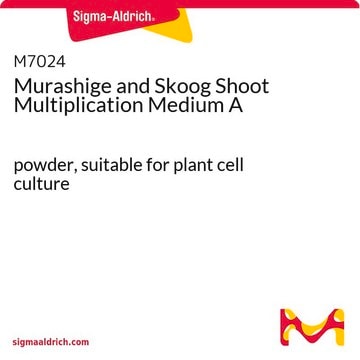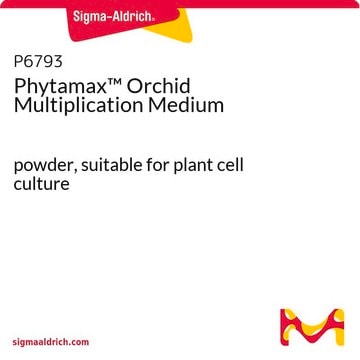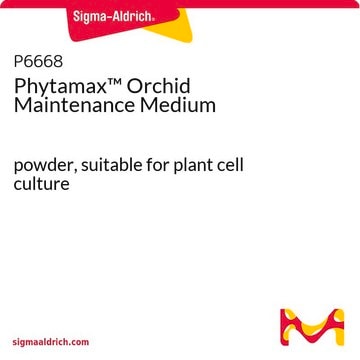Yes, gelation is pH dependent. Adjusting the pH to 5.7 is recommended prior to heating to melt the agar and autoclaving to sterilize. Please see the link below to review the general plant culture medium preparation instructions available in the datasheet for product M5519 (formulation without agar):
https://www.sigmaaldrich.com/deepweb/assets/sigmaaldrich/product/documents/361/537/m5519pis.pdf
Kluczowe dokumenty
M9274
Murashige and Skoog Basal Medium
suitable for plant cell culture, with sucrose and agar
Synonim(y):
MS Basal Medium
Wybierz wielkość
71,40 zł
Wybierz wielkość
About This Item
71,40 zł
Polecane produkty
Poziom jakości
Formularz
powder
metody
cell culture | plant: suitable
Zastosowanie
agriculture
Warunki transportu
ambient
temp. przechowywania
2-8°C
Szukasz podobnych produktów? Odwiedź Przewodnik dotyczący porównywania produktów
Zastosowanie
Wariant wzoru
Media Formulation
Ilość
produkt powiązany
Hasło ostrzegawcze
Warning
Zwroty wskazujące rodzaj zagrożenia
Zwroty wskazujące środki ostrożności
Klasyfikacja zagrożeń
Eye Irrit. 2 - Ox. Sol. 3
Kod klasy składowania
5.1B - Oxidizing hazardous materials
Klasa zagrożenia wodnego (WGK)
WGK 2
Temperatura zapłonu (°F)
Not applicable
Temperatura zapłonu (°C)
Not applicable
Wykazy regulacyjne
Wykazy regulacyjne dotyczą głównie produktów chemicznych. Można w nich podawać ograniczoną liczbę informacji na temat produktów niechemicznych. Brak wpisu oznacza, że żaden ze składników nie znajduje się w wykazie. Użytkownik odpowiada za zagwarantowanie bezpiecznego i zgodnego z prawem stosowania produktu.
EU REACH SVHC Candidate List
EU REACH Annex XVII (Restriction List)
Wybierz jedną z najnowszych wersji:
Certyfikaty analizy (CoA)
Nie widzisz odpowiedniej wersji?
Jeśli potrzebujesz konkretnej wersji, możesz wyszukać konkretny certyfikat według numeru partii lub serii.
Masz już ten produkt?
Dokumenty związane z niedawno zakupionymi produktami zostały zamieszczone w Bibliotece dokumentów.
Klienci oglądali również te produkty
-
Would an incorrect pH level affect the setting of the agar?
1 answer-
Helpful?
-
-
How firm is the gel in the final sterile medium preparation of Murashige and Skoog Basal Medium, Product M9274?
1 answer-
This formulation contains 8g/L of standard agar resulting in fairly firm and rigid culture medium.
Helpful?
-
-
What is the Department of Transportation shipping information for this product?
1 answer-
Transportation information can be found in Section 14 of the product's (M)SDS.To access the shipping information for this material, use the link on the product detail page for the product.
Helpful?
-
-
What is the stability of the prepared Murashige and Skoog Basal Medium, Product M9274?
1 answer-
This agar-containing medium can be stored for 3 to 6 months, depending on the stability of any additional supplements, if stored properly with no observable dehydration of the gel. If the medium appears to darken or pull away from the sides of the culture vessel, it should be discarded.
Helpful?
-
-
How is Murashige and Skoog Basal Medium, Product M9274 different from Product M5519?
1 answer-
M9274 contains sucrose at 30 g/L and agar at 8 g/L; M5519 does not.
Helpful?
-
Active Filters
Nasz zespół naukowców ma doświadczenie we wszystkich obszarach badań, w tym w naukach przyrodniczych, materiałoznawstwie, syntezie chemicznej, chromatografii, analityce i wielu innych dziedzinach.
Skontaktuj się z zespołem ds. pomocy technicznej













